Abstract
This article proposes a method for ontology construction in the field of ancient architecture digitization with the aim of addressing the lack of formalization, sharing, and reusable unified description mechanisms currently observed in the field of ancient architecture digitization. This method defines the related concepts, attributes, and relationships between concepts in the digitization of ancient architecture. It employs the network ontology language OWL to model the ontology in the digitization domain of ancient architecture and realizes the visualization of the ontology in the digitization domain of ancient architecture, thereby providing effective support for the sharing and reuse of digitization knowledge of ancient architecture. Finally, an example of a wooden tower is taken to verify the effectiveness and reliability of the proposed method.
1. Introduction
Ancient architecture has consistently played a key role in the cultural and historical development of nations and countries. It can objectively reflect people’s production, life, social development, cognitive level, thinking, and values. It is well known that China has a rich cultural legacy in the domain of ancient architecture. By the conclusion of 2019, the State Council had formally approved and publicly disclosed a total of eight batches of national key cultural relics protection units, covering a total of 5058 cultural relics protection units across the country. Of the cultural relics protection units, 43.82% are of ancient architectural heritage [1].
The protection of ancient architectures is imminent because a considerable number of ancient architectures throughout the country have suffered various degrees of damage as a result of both man-made and natural disasters [2,3,4]. In recent years, the rapid development of digitization technology has opened up a new avenue for the protection and utilization of ancient architecture. Compared with traditional technology, digitization technology is capable of preserving the information of ancient architectures with greater accuracy and over an extended period of time and provides effective information for the restoration and reconstruction of ancient architecture [5,6,7].
Nowadays, the ongoing advancement of digitization technology has advanced the emergence of novel surveying and mapping techniques, including satellite remote sensing, UAV photogrammetry, and LiDAR, which provide more technical support for the digitization protection of ancient architecture [8,9,10]. Nevertheless, the digitization of ancient architecture still faces certain challenges.
From a multidisciplinary perspective, the digitization of ancient architecture requires the integration of various expertise, including architectural, surveying, mapping, and artistic knowledge. Moreover, the structure of ancient architecture is inherently complex, the selection of methods and equipment is not straightforward, and there is a lack of a unified description mechanism, which causes professionals to be uncertain about the digitization target. Non-professionals, such as conservationists, archaeologists, and historians, lack the expertise to effectively digitize a building. Therefore, there is an urgent need to establish a unified digitized information model of ancient architecture and to develop a system for querying and serving the digitized information in a fast and efficient manner.
Ontology refers to a clear and detailed description of a shared conceptual system [11]. After the emergence of ontology theory, ontology-based research on cultural heritage information has become a research hotspot. The CIDOC/CRM ontology, as proposed by Crofts et al. [12], is primarily utilized for the storage of cultural heritage information. At the same time, CIDOC/CRM proposes a CRMba-compatible model for encoding metadata about archaeological architecture documents, which is built on the same principles as CIDOC/CRM in order to support the process of documenting existing evidence and discontinuities of ancient architecture in order to identify the evolution of architecture throughout the century and record their relationship to each building component and to the building as a whole. Similarly, R. Garozzo et al. [13] presented CulTO1.0, a computational ontology-based modeling software tool in the field of cultural heritage. This tool is specifically oriented toward the investigation of religious historical buildings and is designed to facilitate the work of cultural heritage professionals. As ontology research has progressed, it has increasingly been applied to the field of architectural heritage protection. Acierno et al. [14] have integrated ontology into the protection process of historical architectural heritage, thereby facilitating knowledge representation and management throughout the entire process. Song et al. [15] constructed an ontology for the field of ancient architecture and applied it to an ancient architecture information retrieval system. Chen et al. [16] proposed a unified method for expressing ancient architecture knowledge through ontology-based knowledge expression and case-based reasoning. However, the current research content is mainly information integration and ontology construction for ancient architecture, which does not include the sorting and studying of digitization knowledge about ancient architecture.
At present, ontology construction methods are mainly composed of the saurus transformation ontology and ontology engineering methods [17]. In the former method, domain experts are primarily engaged in the manual or semi-automatic/automated construction of ontologies through the analysis of thesauri. While these methods provide a more comprehensive and professional approach to the concept set and terminology, the relational expression of the ontology is constrained by the structure of the thesaurus. The construction methods of the latter category include the IDEF5 method [18], the skeleton method [19], the TOVE method (an evaluation method) [20], the seven-step method [21], and so forth. The IDEF5 method is unable to perform circular development. The skeleton method is primarily concerned with outlining the procedures and directives associated with ontology development. The seven-step method is predominantly employed for domain ontology construction and possesses a degree of universality. The TOVE method (evaluation method) is an integrated model comprising a first-order logic structure, and the process of knowledge retrieval and acquisition is straightforward.
Ancient architecture digitization domain ontology is a general conceptual model describing knowledge in the field of ancient architecture digitization, and it needs to build concepts in the field of ancient architecture digitization and the relationship between concepts. However, the extraction of concepts and relationships in the field of ancient architecture digitization presents significant challenges. First, ancient architecture itself is a highly complex structure comprising numerous component types. Second, due to the continuous deepening of the research of digitization technology, there are more and more digitization methods and equipment in the market, which brings great obstacles to the extraction of digitization concepts.
In view of the above issue, this article proposes a digitization ontology model of ancient architecture. This model is developed by combining the seven-step method and the skeleton method, with the aim of providing a framework for representing and managing information in the digitization domain related to ancient architecture. The model refers to the extant norms of digitization for ancient architecture and the related literature, divides the digitization knowledge of ancient architecture into four categories—digitization technology, digitization equipment, digitization elements, and digitization norms—and defines the attributes of concepts and the semantic relations between concepts.
Finally, the construction and formal expression of the digitization ontology of ancient architecture are demonstrated with the example of a wooden tower.
2. The Construction Process of Ancient Architecture Digitization Domain Ontology
In light of the intricate knowledge system inherent to the field of ancient architecture digitization, this article proposes an extension of the ontology construction method based on the seven-step approach developed by Stanford University. It adheres to the basic tenets of ontology construction and takes the evaluation approach espoused by the skeleton method as a point of reference. The specific process is illustrated in Figure 1.
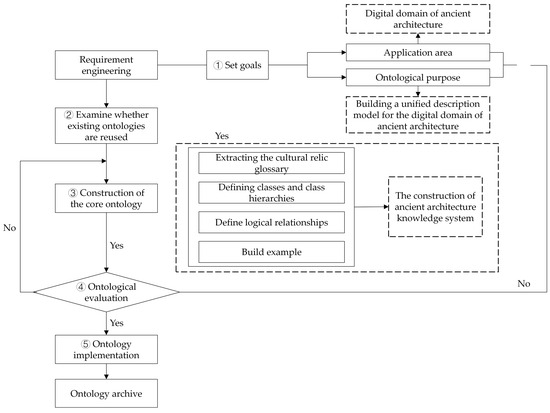
Figure 1.
Ontology construction method in the digitization domain of ancient architecture.
The main steps of ontology construction in the digitization domain of ancient architecture are as follows:
① Identify the application domain and the purpose of the ontology. The scope of the ontology depends on the application domain. Based on the requirements analysis, the domain of ancient architecture digitization was selected as the application domain of the ontology. The goal of studying the ontology for the domain of ancient architecture digitization is to integrate a substantial corpus of knowledge pertaining to the domain of ancient architecture digitization, with the aim of developing a unified semantic description model of knowledge within the domain of ancient architecture digitization. This will facilitate effective digitization work.
② Investigate whether the existing ontology can be reused. Whether there are currently reusable domain-related ontologies, and if so, whether these ontologies can be constructed in a simplified manner. In the field of ancient architecture, the majority of current research is focused on the construction of the ontological knowledge of ancient architecture, with little attention paid to the digitization of ancient architecture. This lack of attention has resulted in a lack of reusable ontologies.
③ Construct the core ontology. In accordance with the enumerated concepts and terms of ancient architectural digitization, the categorization of concepts from definitions facilitates the clarification, logical organization, and coherence of the structure of the ontology. The definition of attributes and relations within a class serves to elucidate the intrinsic characteristics of the concepts and to establish semantic associations between them. An instance represents a concrete description of an ontology, serving to verify the completeness and validity of the aforementioned definitions.
④ Evaluate the ontology. The evaluation of domain experts allows for the effective avoidance of non-standard concept terms in ontology construction, thereby improving the ontology.
⑤ Implement and archive the ontology. The ontology that conforms to the established standard has been realized and archived, thus completing the construction of the ontology.
3. Ontology Construction in the Digitization Domain of Ancient Architecture
3.1. Classification and Expression of Concepts
In the context of an ontology model, the establishment of a conceptual layer represents a crucial step in the ontology development process. By employing a multi-level division and expression of concepts, the ontology can facilitate the construction of more comprehensive semantic spatial information and increase the reuse rate of the ontology. In the digitization ontology design of ancient architecture, this article synthesizes the general digitization workflow of ancient architecture and divides it into four technical specification steps. First, the preparatory work is carried out, including site exploration, data collection and program formulation. Then, data collection is carried out; various data devices are used, such as UAVs, 3D laser scanners, total stations, and so on. Different types of data (point cloud, image, and archive) are collected, then the point cloud data, image data, and archive data are processed. Finally, the result data are output in formats such as a three-dimensional model, an orthorectified image, digital documents, etc., as shown in Figure 2.
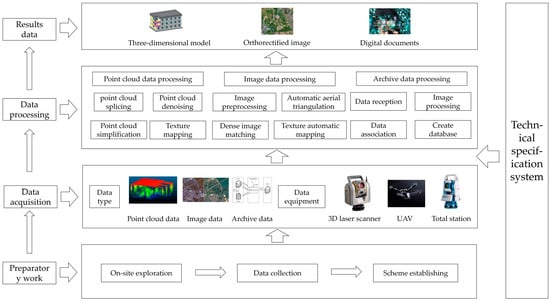
Figure 2.
Digitization flow and frame diagram of ancient architecture.
In addition, based on a large number of existing literature and engineering cases related to the digitalization of ancient architecture. The digitization knowledge of ancient architecture is classified into four main categories: the digitization object of ancient architecture, the digitization technology of ancient architecture, the digitization equipment of ancient architecture, and the digitization specification of ancient architecture. Furthermore, on this basis, the concept of ancient architecture digitization ontology is divided into four levels, and the conceptual ontology framework of the ancient architecture digitization domain knowledge is constructed in more detail as shown in Figure 3.
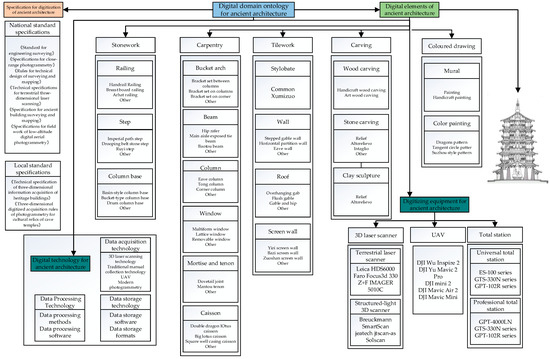
Figure 3.
Concept system of ancient architecture digitization ontology (part).
Among them, the digitization objects of ancient architecture refer to the key components that need to be preserved in the digitization work and the associated cultural relics of important value. This article primarily addresses the topic of ancient wooden structures, with a particular focus on the Yingzao Fashi [22], which categorizes digitization objects into five secondary conceptual categories: stonework, carpentry, tilework, carving, and color painting. The digitization technology of ancient architecture is defined as the technical methods involved in the digitization process. In recent years, there has been remarkable progress in the field, with the emergence of numerous methodologies. In accordance with the digitization workflow and the substantial corpus of literature, this article classifies the digitization technology of ancient buildings into three secondary categories: data acquisition technology, data processing technology, and data storage technology. The digitization equipment of ancient buildings is a necessary tool for data acquisition. By summarizing and sorting the equipment available on the market has led to the delineation of three secondary categories of digitization equipment: unmanned aerial vehicles (UAV), total stations, digital cameras, and three-dimensional (3D) laser scanners. The digitization specification of ancient architecture is used to describe the technical requirements that must be met in order to digitally document and preserve ancient structures. The aforementioned categories are further subdivided into two secondary categories: national standards and local standards. In order to provide the most comprehensive description of the research object, this article divides some of the conceptual classes into three and four levels, respectively. For example, the second-level carvings are divided into three third levels: wood carvings, clay sculptures, and stone carvings. Among these, wood carvings are further divided into two fourth levels: craft wood carvings and art wood carvings. In the process of ontology construction, the concept classes of ancient architecture digitization ontology that cannot be directly divided correspond to the corresponding examples.
3.2. The Structure of Digitization Ontology of Ancient Architecture
This article uses Web Ontology Language (OWL) to provide a formal description of the digitization ontology of ancient architecture. OWL is an extension of the Resource Description Framework (RDF) that uses triples to describe resources and introduces additional constraints on structure and content. The digitization ontology can be represented as follows:
The “Concept” represents the aggregation of all digitization concepts related to ancient architecture. It includes the aforementioned hierarchical classification of digitization concepts related to ancient architecture.
The “Property” can be divided into two categories: data properties and object properties. Data properties represent and describe the nature of the object itself, such as the name of ancient buildings, structure type, and geographic location. Object attributes represent the association relationship between two objects. Common object attributes include “kind of”, “part-of”, “instance-of”, and “is-a”.
The “Individual” represents a specific digitized work of ancient architecture, which is composed of a collection of object instances. This could be exemplified by the digitization work of a wooden tower.
The “Axiom” represents a fundamental truth or principle that is universally accepted as a basis for reasoning or justification. It clarifies the interrelationships between concepts, such as the digitization of ancient architectural structures.
The structure of the ancient architecture digitization domain ontology is shown in Figure 4.
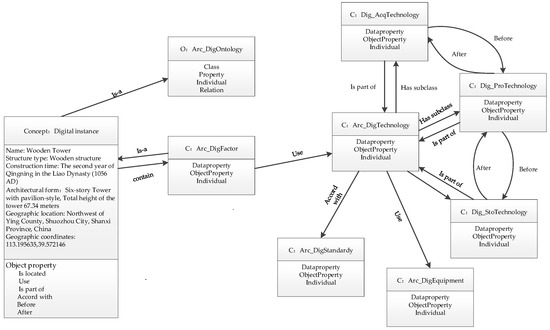
Figure 4.
Digitization ontology structure frame of ancient architecture.
3.3. The Relationship of Ancient Architecture Digitization Ontology
The digitization ontology of ancient architecture is used to describe the potential relationships between digitization concepts. The ontological relations are primarily classified into 12 categories, including upper and lower relationships, temporal relationships, spatial relationships, identity relationships, and cross relationships. However, in the context of digitization in the field of ancient architecture, such a complex relationship is not necessary. Instead, the focus should be on clearly articulating the digitization process of ancient architecture. Based on the characteristics of digitization in ancient architecture and an analysis of the aforementioned relationships, the primary relationships in the digitization of ancient architecture are identified and presented in Table 1.

Table 1.
Ontology relation table of ancient architecture digitization domain.
3.4. The Attribute of Ancient Architecture Digitization Ontology
In order to express the attribute dimension information of the digitization concept of ancient architecture in the ontology model, the method of defining attributes is typically used. Attributes are divided into two categories: numeric attributes and object attributes. A numeric attribute is a dimension of information used to describe a concept, where a particular attribute describes the characteristics of a particular aspect of the object.
Since different faceted attributes are orthogonal in the semantic space, defining as many attribute facets as possible so as to enrich the semantic information and improve the expression of concepts is the basis for realizing ontology sharing and reuse in the field of ancient architecture digitization. The ontology of ancient architecture digitization mainly includes four categories: general attributes of ancient architecture, attributes of ancient architecture elements, attributes of digitization equipment, and attributes of digitization technology; see Table 2 for details.

Table 2.
Ancient architecture digitization ontology concept attribute table.
The object attribute is employed to abstract the relationship between concepts, and its domain of definition and scope are concepts. Through the definition of object attributes, the complex semantic relationship between the digitization of ancient buildings is realized. The object attributes of the digitization ontology of ancient architecture are mainly classified into four categories: “Is part of”, “Constraint”, “Use”, and “Contain”, as illustrated in Table 3.

Table 3.
Semantic relation table of digitization ontology of ancient architecture.
4. Application Case
4.1. Experimental Object
The wooden tower was constructed in the second year of Qingning, which corresponds to the third year of Zhihe in the Song Dynasty (1056 AD). It is the tallest and oldest wooden tower in China and has been designated as a national key cultural relics protection unit, see Figure 5a. The wooden tower is 67.31 m high and 30.27 m in diameter at the bottom, see Figure 5b, with a total weight of more than 7400 tons. The main body was made with the North China larch wood; the arch was made with elm wood. The amount of wood used was up to tens of thousands of cubic meters. The whole building consists of the tower base, tower body, and tower brake (three parts) divided into an upper and lower layer. The lower layer is square, the upper layer is octagonal. The tower body has an octagonal shape, with five layers and six eaves, with five layers visible and four layers interspersed, making it a nine-story tower. Over the past millennium, the wooden tower has suffered significant deformation and damage due to a combination of natural disasters, man-made damage, and other factors, see Figure 5c. The event of an unexpected natural disaster, such as an earthquake, windstorm, etc., will seriously endanger the safety of the wooden tower itself, see Figure 5d. Therefore, it is imperative that the digital protection of the wooden tower be implemented without delay.
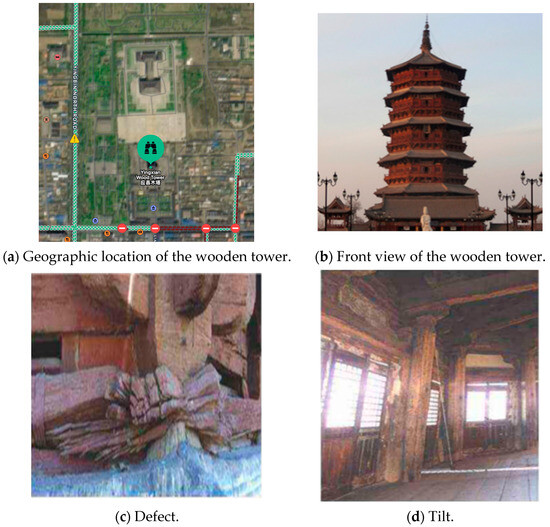
Figure 5.
Overview image of the wooden tower.
To meet the requirements for the protection and repair of the wooden tower, this article employs a digitization ontology model of ancient architecture to digitize the tower. The digitization ontology model of ancient architecture has been rigorously validated throughout the digitization process of the wooden tower.
4.2. Experimental Process and Results
Based on the ontology model in the field of ancient architecture digitization, this digitization work firstly used on-site investigation and the literature review to clarify the elements required for digitization in the digitization process of the wooden tower, such as murals, beams, statues, roofs, the dougong, etc., as shown in Figure 6 and Figure 7. It can be seen that the key elements of the wooden tower can be classified into three main categories: structural components, decorative elements, and accompanying cultural relics. The structural components include beams, columns, bucket arches, fangs, doors, windows, and other components. The decorative elements include caissons, murals, and other such features, like ancillary cultural relics such as plaques and Buddha statues, etc.
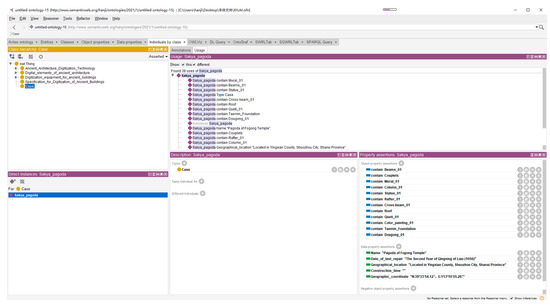
Figure 6.
The wooden tower digitization elements.
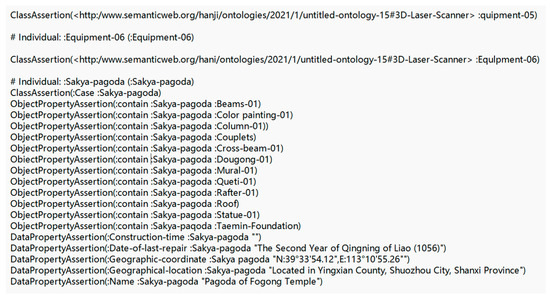
Figure 7.
The wooden tower formal ontology description fragment.
Second, the digitization elements of the wooden tower were defined, after which the corresponding components were selected from the aforementioned digitization ontology model of ancient architecture. Then, the digitization technology and corresponding equipment that meet the required accuracy were then selected according to the defined attribute information in the digitization ontology model of ancient architecture, see Table 4 for details. This section describes the relationship between digitization elements, digitization equipment, the storage format, and specifications in the digitization process of the wooden tower from both semantic and spatial perspectives. It also presents a complete ontology model of the digitization process of the wooden tower, as shown in Figure 8. The complex structure of the wooden tower and the limitations of the working environment necessitate frequent changes of station for the traditional fixed laser scanner, resulting in a markedly low data acquisition efficiency. To solve this problem, a handheld scanner based on SLAM technology was selected in the digitization ontology model of ancient buildings for integrated data acquisition inside and outside the tower, thereby obtaining the point cloud data. Concurrently, the appropriate UAV equipment was selected in the ontology database to obtain the image data in the protected area of the wooden tower and establish the digitization document.

Table 4.
The wooden tower digitization ontology instance attribute table (part).
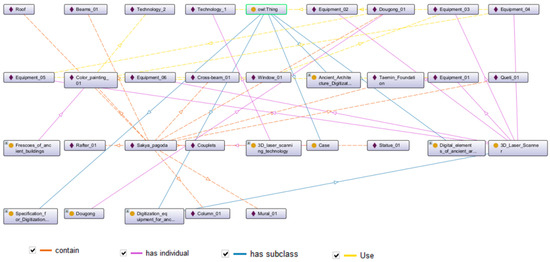
Figure 8.
The wooden tower digital ontology (Part).
Ultimately, a digitization representation of the wooden tower was developed according to the aforementioned digitization ontology, and its details are shown in Figure 9. It can be seen that the ontology model of the digitized domain of ancient architecture constructed in this article can not only clearly and completely express the digitization process of a certain building, but also fully describe the relationship between the various elements, thus enabling the construction and visualization of the digitized domain ontology of ancient architecture.
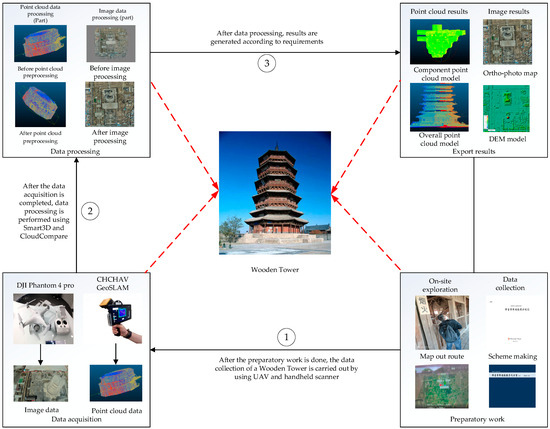
Figure 9.
The wooden tower digitization flow chart.
Through the ontology model of the digitization field of ancient architecture and the combination of AI and digitization, the wooden tower can be digitally constructed, and the expectant results are shown in Figure 10. At the same time, the audience can simulate climbing the tower through digital technology for thousands of years and feel the unique charm of the wooden tower. This technology has now landed and has achieved several major breakthroughs such as the digital restoration of ancient build-ings and the integration of ancient and modern technologies. It can be seen that not only for wooden towers, but also for other ancient buildings, the digital construction and visualization of ancient buildings can be realized by building digital domain on-tology models, and through data comparison, the state changes of the building in the past hundred years can be summarized, which is of great significance for protection and restoration.
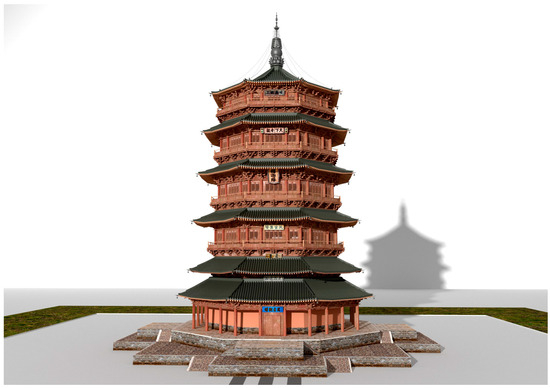
Figure 10.
The wooden tower digitization results.
The digital ontology construction work performed in this paper and the ontology model of ancient architecture digitalization field proposed in this paper can break through the knowledge barriers between researchers and cultural relics workers and can adeptly construct digital ontology for general, basic, and simple buildings. However, it also has many limitations. In the face of special structures of ancient buildings or special requirements, a single guideline code operation cannot be applied to all complex buildings and more detailed requirements and human intervention is needed to adjust it. In the future, we will continue this research with the aim of solving the problems caused by the limitations of the construction base.
5. Conclusions
In this article, due to the lack of combing of knowledge in the field of ancient architecture digitization, the problem of not being able to effectively carry out digitization work, etc., has arisen. This paper researches the construction method of the ontology of the field of ancient architecture digitization and carries out the hierarchical classification and formal expression of the concepts, attributes, and relationships involved in the field of ancient architecture digitization to realize the construction of ontology of the ancient architecture digitization field. Furthermore, the ontology model is applied to the digitization work of a wooden tower, resulting in the construction of a digitization ontology of the wooden tower. The experimental results demonstrate that the ontology developed in this article is fully capable of adequately describing the semantic aspects of the digitization process of ancient architecture, including both the concepts and the semantic relationships involved. In addition to validating the soundness and dependability of the constructed ontology, the results also offer a novel approach to knowledge representation in the field of ancient architecture digitization.
Nevertheless, the current digitization ontology model of ancient architecture is limited in scope, encompassing a single object and a restricted type of technical method. We hope that on this basis, combined with the conceptual relationships defined in the ontology, rules can be learned, summarized, and discovered from the existing historical case data. Furthermore, the relevant digitization knowledge of ancient architecture can be refined to improve the cognition and expression of complex relationships in the digitization process. Subsequent research will examine the evolving characteristics of digitization data pertaining to ancient architecture. This will inform the design of a dynamic model structure for the digitization domain ontology of ancient architecture. In addition, a practical spatial analysis and visual retrieval tool will be developed.
Author Contributions
Conceptualization, Y.W., Y.D.; methodology, Y.W.; software, Y.D.; validation, Y.W., Y.D.; formal analysis, Y.W.; investigation, Y.D.; resources, Y.W.; data curation, Y.W.; writing—original draft preparation, Y.D.; writing—review and editing, Y.W.; visualization, Y.D.; supervision, Y.D.; project administration, Y.D.; funding acquisition, Y.D. All authors have read and agreed to the published version of the manuscript.
Funding
This research was funded by the National Natural Science Foundation of China under grants 42301516, the Beijing Natural Science Foundation Project—Municipal Education Commission Joint Fund Project (No. KZ202110016021), the Beijing Municipal Education Commission Scientific Research Project—Science and Technology Plan General project (No. KM202110016005), and the Fundamental Research Funds for the Beijing University of Civil Engineering and Architecture (No. X20043).
Institutional Review Board Statement
Not applicable.
Informed Consent Statement
Not applicable.
Data Availability Statement
The original contributions presented in this study are included in the article; further inquiries can be directed to the corresponding author.
Conflicts of Interest
The authors declare no conflicts of interest.
References
- The State Council. Circular of the State Council on Verifying and Announcing the Eighth Batch of Major sites protected for Their Historical and Cultural value at the National Level. Gaz. State Counc. People’s Repub. China 2019, 30, 9–37. [Google Scholar]
- Chai, X.; Dong, Y.; Li, Y. Waterlogging Assessment of Chinese Ancient City Sites Considering Microtopography: A Case Study of the PuZhou Ancient City Site, China. Remote Sens. 2022, 14, 4417. [Google Scholar] [CrossRef]
- Li, B.; Dong, Y.; Qiao, Y.; Hou, M.; Wen, C. Natural Disaster Risk Monitoring for lmmovable Cultural Relics Based on Digital Twin. J. Geod. Geoinf. Sci. 2024, 7, 90–104. [Google Scholar] [CrossRef]
- Romão, X.; Paupério, E.; Pereira, N. A framework for the simplified risk analysis of cultural heritage assets. J. Cult. Herit. 2016, 20, 696–708. [Google Scholar] [CrossRef]
- Dong, Y.; Hou, M.; Xu, B.; Li, Y.; Ji, Y. Ming and Qing Dynasty Official-Style Architecture Roof Types Classification Based on the 3D Point Cloud. ISPRS Int. J. Geo-Inf. 2021, 10, 650. [Google Scholar] [CrossRef]
- Huo, P.; Hou, M.; Dong, Y.; Li, A.; Ji, Y.; Li, S. A Method for 3D Reconstruction of the Ming and Qing Official-Style Roof Using a Decorative Components Template Library. ISPRS Int. J. Geo-Inf. 2020, 9, 570. [Google Scholar] [CrossRef]
- Andriasyan, M.; Moyano, J.; Nieto-Julián, J.E.; Antón, D. From Point Cloud Data to Building Information Modelling: An Automatic Parametric Workflow for Heritage. Remote Sens. 2020, 12, 1094. [Google Scholar] [CrossRef]
- Ge, Y.; Guo, B.; Zha, P.; Jiang, S.; Jiang, Z.; Li, D. 3D Reconstruction of Ancient Buildings Using UAV Images and Neural Radiation Field with Depth Supervision. Remote Sens. 2024, 16, 473. [Google Scholar] [CrossRef]
- Abdel-Maksoud, H. Combining UAV-LiDAR and UAV-photogrammetry for bridge assessment and infrastructure monitoring. Arab. J. Geosci. 2024, 17, 144. [Google Scholar] [CrossRef]
- Banfi, F.; Roascio, S.; Mandelli, A.; Stanga, C. Narrating Ancient Roman Heritage through Drawings and Digital Architectural Representation: From Historical Archives, UAV and LIDAR to Virtual-Visual Storytelling and HBIM Projects. Drones 2023, 7, 51. [Google Scholar] [CrossRef]
- Gruber, T.R. A translation approach to portable ontology specifications. Knowl. Acquis. 1993, 5, 199–220. [Google Scholar] [CrossRef]
- Crofts, N.; Doerr, M.; Gil, T. The CiDOC Conceptual Reference Model: A standard for communicating cultural contents. Cultiv. Interact. 2003, 9, 2. [Google Scholar]
- Garozzo, R.; Murabito, F.; Santagati, C.; Pino, C.; Spampinato, C. CulTO: An ontology-based annotation tool for data curation in cultural heritage. Int. Arch. Photogramm. Remote Sens. Spat. Inf. Sci. 2017, 42, 267–274. [Google Scholar] [CrossRef]
- Acierno, M.; Cursi, S.; Simeone, D.; Fiorani, D. Architectural heritage knowledge modelling: An ontology-based framework for conservation process. J. Cult. Herit. 2017, 24, 124–133. [Google Scholar] [CrossRef]
- Song, Y.; Qian, L. Ontology Model of Ancient Chinese Architecture Members and Culture Design and Application. J. Beijing Univ. Civ. Eng. Archit. 2012, 28, 48–52+64. [Google Scholar]
- Chen, W. Knowledge Expression and Case-Based Reasoning of Ancient Architecture Based on Ontology. Master’s Dissertation, Xi’an University of Architecture and Technology, Xi’an, China, 2020. [Google Scholar] [CrossRef]
- Sattar, A.; Surin, E.S.M.; Ahmad, M.N.; Ahmad, M.; Mahmood, A.K. Comparative Analysis of Methodologies for Domain Ontology Development: A Systematic Review. Int. J. Adv. Comput. Sci. Appl. 2020, 11, 99–108. [Google Scholar] [CrossRef]
- Franklin, A.; Uff, J.S.; Spencer, J. Anal neurofibrosarcoma treated with fast neutron irradiation. Br. Med. J. 1978, 1, 959. [Google Scholar] [CrossRef] [PubMed][Green Version]
- Uschold, M.; Gruninger, M. Ontologies: Principles, methods and applications. Knowl. Eng. Rev. 1996, 11, 93–136. [Google Scholar] [CrossRef]
- Tham, K.D.; Fox, M.S.; Gruninger, M. A cost ontology for enterprise modelling. In Proceedings of the 3rd IEEE Workshop on Enabling Technologies: Infrastructure for Collaborative Enterprises, Morgantown, WV, USA, 17–19 April 1994; IEEE: Piscataway, NJ, USA, 1994; pp. 197–210. [Google Scholar]
- Swartout, B.; Patil, R.; Knight, K.; Russ, T. Toward distributed use of large-scale ontologies. In Proceedings of the Tenth Workshop on Knowledge Acquisition for Knowledge-Based Systems, Banff, AB, Canada, 9–14 November 1996; Volume 138, p. 25. [Google Scholar]
- Liang, S. Preface to the Yingzao Fashi commentary. J. Archit. Hist. 2022, 3, 178. [Google Scholar]
- DB11/T1796-2020; Technical Specification of Three-Dimensional Information Acquisition of Heritage Buildings. Beijing Market Supervisory Authority: Beijing, China, 2020.
Disclaimer/Publisher’s Note: The statements, opinions and data contained in all publications are solely those of the individual author(s) and contributor(s) and not of MDPI and/or the editor(s). MDPI and/or the editor(s) disclaim responsibility for any injury to people or property resulting from any ideas, methods, instructions or products referred to in the content. |
© 2024 by the authors. Licensee MDPI, Basel, Switzerland. This article is an open access article distributed under the terms and conditions of the Creative Commons Attribution (CC BY) license (https://creativecommons.org/licenses/by/4.0/).